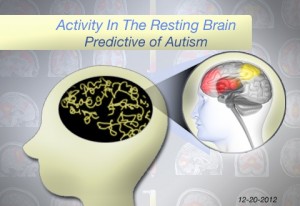Check out other stories from the Latest News
Resting State Brain Activity Shows Familial ASD Risk
By Chelsea E. Toledo, M.A. on December 19, 2012

Background: Recent evidence suggests that activity in the default mode network (DMN), a collection of brain areas that becomes active during restful waking states—such as during daydreaming—may be associated with Autism Spectrum Disorder (ASD). Researchers can use functional magnetic resonance imaging (fMRI) to visualize brain activity while individuals are at rest or performing goal-oriented tasks. The DMN becomes inactive during task performance. In individuals with ASD, however, task-dependent deactivation of this network is reduced.
What’s New: In a report published in the November issue of PLoS ONE, researchers examined the DMN’s activity in high-functioning adults with ASD as they performed tasks related to language, discerning themselves from others, and theory-of-mind, which involves attributing emotions or beliefs to themselves and others. Using fMRI to measure the brain activity of 13 individuals with ASD and 14 typically developing counterparts, they were able to detect that the DMN of autistic individuals mapped differently during theory-of-mind tasks in particular. While the typically developing individuals’ DMN were inactive during those tasks, the DMN was more active in the autistic individuals. An additional study, published in Molecular Autism, observed altered DMN patterns both in autistic individuals and in their siblings who did not have ASD.
Why it’s important: In addition to finding differences in the DMN activity between autistic and typically developing individuals, the authors of the PLoS ONE study used that measurement to identify autistic individuals with 96.3 percent accuracy. In conjunction with the Molecular Autism paper, that finding suggests that measuring DMN activity could prove a reliable assessment of familial risk for ASD.
Help me understand :
| Source(s) : |
| Tweet |

